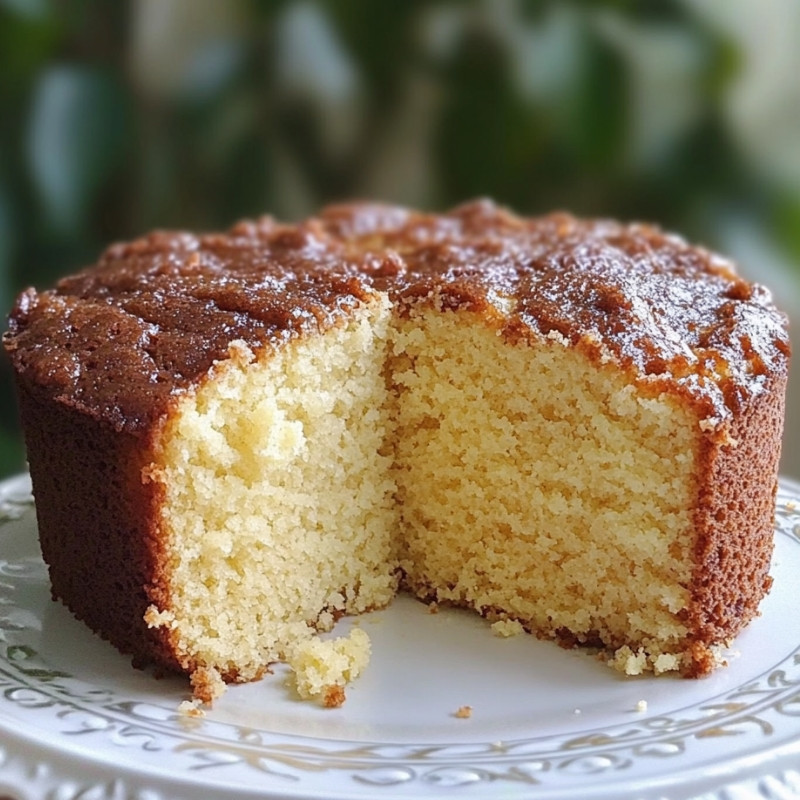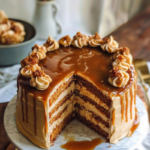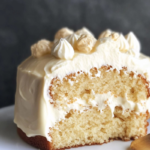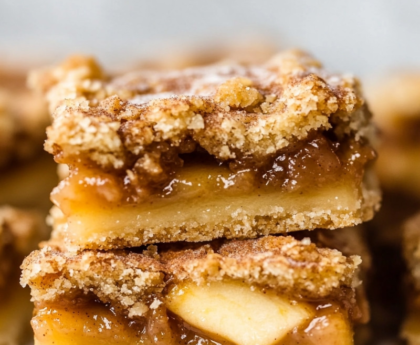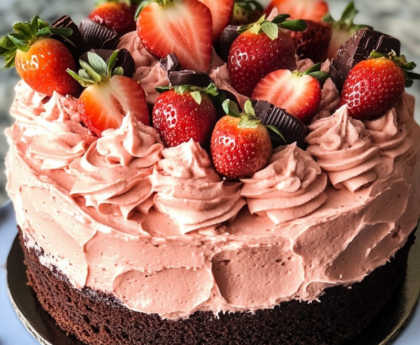Introduction
Old-Fashioned Butter Cake is a timeless classic that evokes the warmth and comfort of home baking. This rich and buttery treat boasts a soft crumb and delightful flavor, making it perfect for any occasion—from birthdays to simple family gatherings. An impressive yet straightforward recipe, this cake is sure to become a favorite in your collection.
Ingredients
– 250g unsalted butter, softened
– 300g granulated sugar
– 4 large eggs
– 300g all-purpose flour
– 10g baking powder
– 2g salt
– 240ml whole milk
– 10ml vanilla extract
Prep Time
15 minutes
Cook Time, Total Time, Yield
Cook Time: 45 minutes
Total Time: 1 hour
Yield: 8-10 servings
Directions
1. Preheat the oven to 175°C. Grease and flour a 23cm round cake pan.
2. In a large mixing bowl, cream the butter and sugar together until light and fluffy.
3. Add the eggs one at a time, beating well after each addition.
4. In a separate bowl, whisk together the flour, baking powder, and salt.
5. Gradually add the dry ingredients to the butter mixture, alternating with the milk. Begin and end with the dry ingredients.
6. Stir in the vanilla extract until well combined.
7. Pour the batter into the prepared cake pan and smooth the top.
8. Bake for 40-45 minutes, or until a toothpick inserted into the center comes out clean.
9. Allow the cake to cool in the pan for 10 minutes, then transfer to a wire rack to cool completely before serving.
Detailed Directions and Instructions
Step 1: Preheat the Oven
Preheat your oven to 175°C (350°F). While the oven is heating, take a 23cm round cake pan and grease it with butter or non-stick spray, then dust it with flour to ensure the cake doesn’t stick.
Step 2: Cream Butter and Sugar
In a large mixing bowl, combine the softened unsalted butter (250g) with granulated sugar (300g). Using an electric mixer on medium speed, cream the butter and sugar together until the mixture becomes light and fluffy, which should take about 3-5 minutes.
Step 3: Add Eggs
Crack the eggs (4 large) one at a time into the butter-sugar mixture. Beat the mixture well after each egg addition to ensure that it is fully incorporated and smooth.
Step 4: Combine Dry Ingredients
In a separate bowl, whisk together all-purpose flour (300g), baking powder (10g), and salt (2g). This will help evenly distribute the baking powder and salt throughout the flour.
Step 5: Mix Dry Ingredients and Milk
Gradually add the dry ingredients to the butter-egg mixture, alternating with whole milk (240ml). Begin by adding one-third of the dry mixture, followed by half of the milk, mixing well after each addition. Repeat until all the ingredients are combined, starting and ending with the dry ingredients.
Step 6: Add Vanilla Extract
Pour in the vanilla extract (10ml) and stir until it is fully incorporated into the batter. Ensure there are no lumps and the mixture is smooth.
Step 7: Prepare for Baking
Carefully pour the batter into the prepared cake pan. Use a spatula to smooth the top of the batter to ensure even baking.
Step 8: Bake the Cake
Place the cake pan in the preheated oven and bake for 40-45 minutes. Keep an eye on the cake towards the end of the baking time. It is done when a toothpick inserted into the center comes out clean.
Step 9: Cool the Cake
Once baked, take the cake out of the oven and allow it to cool in the pan for 10 minutes. After that, gently transfer the cake to a wire rack to cool completely before slicing and serving.
Notes
Storage
The butter cake can be stored in an airtight container at room temperature for up to 3 days or in the refrigerator for up to a week.
Serving Suggestions
This cake is delicious on its own or can be served with fresh fruit, whipped cream, or a simple glaze for added flavor.
Variations
Feel free to experiment by adding citrus zest, chocolate chips, or nuts to the batter for different flavor profiles.
Common Mistakes
Be careful not to overmix the batter after adding the flour, as this can lead to a dense cake. Ensure all ingredients are at room temperature for the best results.
Cook techniques
Creaming Butter and Sugar
Creaming butter and sugar together until light and fluffy is crucial for incorporating air into the mixture, resulting in a lighter cake. Use room temperature butter for best results and beat the mixture for several minutes.
Incorporating Eggs
Add eggs one at a time, ensuring each egg is fully incorporated before adding the next. This method helps in achieving an emulsified batter, leading to a tender crumb.
Mixing Dry Ingredients
Whisk the all-purpose flour, baking powder, and salt together before adding to the butter mixture. This ensures even distribution of the leavening agent for a uniform rise.
Alternating Ingredients
When adding the dry ingredients and milk, do so in alternating batches. This method helps to keep the batter smooth and prevents overmixing, which can lead to a denser cake.
Baking
Preheat the oven before placing the cake inside to ensure even cooking. Keep an eye on the cake towards the end of the baking time and perform the toothpick test to check for doneness.
Cooling the Cake
Allow the cake to cool in the pan for a short time before transferring it to a wire rack. This helps in setting the structure while making it easier to remove without breaking.
FAQ
Can I use salted butter instead of unsalted butter?
Yes, you can use salted butter, but it may alter the taste of the cake slightly. If using salted butter, you can omit the added salt in the recipe.
How do I know when the cake is done baking?
A toothpick inserted into the center of the cake should come out clean or with a few crumbs. If it has wet batter on it, the cake needs more time in the oven.
Can I substitute whole milk with another type of milk?
Yes, you can substitute whole milk with other milk varieties such as 2% milk or almond milk, but it may affect the texture and richness of the cake.
How should I store the cake after baking?
Store the cake in an airtight container at room temperature for up to 3 days. For longer storage, you can freeze it wrapped tightly in plastic wrap.
Can I add flavorings or mix-ins to the cake batter?
Absolutely! You can add lemon zest, almond extract, chocolate chips, or nuts for added flavor and texture. Just be sure to adjust the measurements accordingly.
Conclusion
The Old-Fashioned Butter Cake is a timeless delight that embodies the warmth and comfort of home baking. Its rich flavor and soft texture make it a versatile choice for any celebration or casual gathering. Whether enjoyed plain or dressed up with toppings, this cake is sure to bring joy to anyone fortunate enough to taste it.
Classic Buttercream Frosting
Enhance your butter cake with a simple and delicious homemade buttercream frosting. Whip together unsalted butter, powdered sugar, vanilla extract, and a splash of milk for a creamy topping.
Fresh Berry Compote
Pair the cake with a fresh berry compote made from strawberries, blueberries, and raspberries. Simply cook the berries with a little sugar and lemon juice until they soften and start to break down.
Lemon Zest Glaze
Brighten up the cake with a zesty lemon glaze. Combine powdered sugar with fresh lemon juice and a bit of lemon zest for a refreshing finish that complements the buttery flavor.
Cinnamon Sugar Topping
For a cozy twist, sprinkle a mixture of cinnamon and granulated sugar on top of the batter before baking. This will create a deliciously fragrant crust that adds warmth to each slice.
Chocolate Ganache Drizzle
Indulge in a rich chocolate ganache made from dark chocolate and heavy cream. Drizzle it over the cooled cake for a decadent touch that chocolate lovers will adore.
Caramel Sauce
Drizzle warm caramel sauce over the cake for a sweet and buttery contrast. You can even add a sprinkle of sea salt for a delightful salted caramel flavor.
Nut Topping
Enhance the texture of your butter cake by adding a topping of chopped nuts, such as walnuts or pecans, either mixed into the batter or sprinkled on top before baking.
Fruit Layering
Layer slices of the butter cake with whipped cream and fresh fruits such as peaches or strawberries for a delightful shortcake-style dessert that feels light and refreshing.

